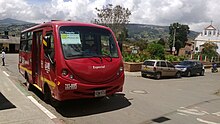Integrated Public Transport System (Bogotá)
During the 2007 campaign for the election of mayor of the city, the candidate Samuel Moreno Rojas had as a campaign proposal, in addition to the construction of phase III of TransMilenio and the Bogotá Metro, the implementation of an ambitious project whose mission was to order and integrate the traditional public transport system with TransMilenio.
In October 2009 and then as mayor, Moreno announced the start of the tender of the 13 zones in which the city was divided and to which an operator and the System of Collection and Control of Information (Sirci) would be assigned.
During the first four days of March 2010, the Moreno administration suffered one of the biggest crises with a transporters strike demanded their inclusion in the SITP and managing to paralyze the city.
Finally, and after extensive negotiations, Moreno and the transporters agreed to include them among the bidding companies and scrap projects for the very old buses that could not enter the system, which implied a delay in the assignment of the operators.
In spite of the promises of the manager of TransMilenio during that time, Fernando Páez, that the SITP would begin operations in December 2011, due to delays in the delivery of phase III of said system, Paéz himself had to say in September that it would not be until May 2012 when the gradual implementation of routes could be initiated.
Finally, on December 31 and after three years of delay, the mayor in charge of Bogotá, Clara López, received the works of Phase III of TransMilenio, which meant a great advance in unlocking the implementation of the system.
In January 2012, with the entry of Gustavo Petro to the mayor's office and a new cabinet, it was reported that the works of phase III were incomplete and that there would still be time until the start of their operations.
On June 30, despite pressure from various sectors, Gobernación and El Dorado Portal stations began operation on Calle 26 for free due to delays in the implementation of the fare collection system.
According to subsequent investigations, the bus had all its revisions up to date, however, this tragic event caused a wave of control by the authorities that revealed the precarious state of the old buses used in the system.
[1] After a long debate and a large number of proposals dating from mayor Moreno, it has been said that Carrera Séptima will be served by hybrid buses that would connect to TransMilenio at the National Museum station and that they would start operating by mid-December 2013.
[3] It has six services that fulfill a specific function, and each one is identified with the color of the vehicles: TransMiCable and trunk (red), feeder (green), urban (blue), complementary (orange) and special (maroon) buses.
Some of them are: The urban area of Bogotá is divided into 13 zones and a neutral zone, which are operated and integrated together with the current and future trunk lines of TransMilenio, Metro, TransMiCable and commuter train as follows: Neutral Usaquén East Suba Center Suba Calle 80 Engativá Fontibón Tintal - Zona Franca Kennedy Bosa Perdomo Ciudad Bolívar Usme San Cristóbal Soacha They correspond to the trunk bus system and zonal buses, that is, the special, complementary, urban buses and also the TransMilenio feeder buses.






